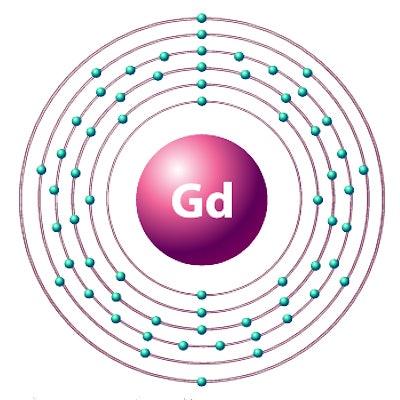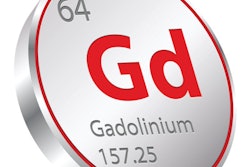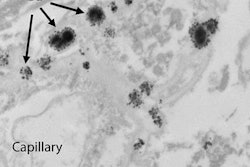
A meta-analysis of gadolinium-based contrast agents (GBCAs) for MRI scans found that one linear GBCA had a lower rate of immediate allergic reactions than macrocyclic gadolinium contrast, according to results published online August 25 in Radiology.
The findings appear to complicate the conventional wisdom about gadolinium contrast, in which macrocyclic GBCAs are considered to be safer for patients in terms of avoiding nephrogenic systemic fibrosis (NSF) and gadolinium retention, when the agent remains in certain regions of the brain long after administration.
In the current study, gadodiamide, a nonionic linear agent marketed under the brand name Omniscan by GE Healthcare, registered the lowest rate of allergic reactions, at 1.5 events per 10,000 administrations (Radiology, August 25, 2017).
"The favorable low reaction rate for nonionic linear GBCAs stands in contrast to their worrisome lower kinetic stability, which is thought to increase the risk of nephrogenic systemic fibrosis and gadolinium retention in the brain," wrote lead author Dr. Ashkan Heshmatzadeh Behzadi and colleagues from Weill Cornell Medical Center. "Because risk of development of nephrogenic systemic fibrosis can be decreased by screening renal function before administration, nonionic linear agents may be considered for patients with normal renal function who are at increased risk of allergic reactions."
Long-running concerns
The debate over gadolinium MRI contrast has taken on a life of its own for several years now. Back in the last decade, clinicians were warned not to use GBCAs for MRI scans of patients with insufficient renal function for fear they may develop NSF. Increasing awareness of gadolinium deposition has added a new layer of concern about GBCA safety.
Meanwhile, the rate of immediate reactions to GBCAs is "extraordinarily low," making it difficult to obtain sufficient numbers of patients and administrations to compare the agents' safety rates, according to the researchers. In their meta-analysis, they decided to compare rates of different agents based on three categories of chemical structure and properties:
- Linear versus macrocyclic
- Ionic versus nonionic
- Protein-binding versus nonprotein binding
Behzadi and colleagues searched PubMed and Google Scholar databases for all published studies through February 2017. They grouped GBCAs into linear or macrocyclic categories, as well as whether they were ionic or nonionic.
The macrocyclic GBCAs included gadoterate (Dotarem, Guerbet), gadobutrol (Gadovist, Bayer HealthCare), and gadoteridol (ProHance, Bracco Diagnostics).
The linear GBCAs included gadoxetate (Eovist, Bayer), gadopentetate dimeglumine (Magnevist, Bayer), gadofosveset trisodium (Ablavar, Lantheus Medical Imaging), and gadobenate dimeglumine (MultiHance, Bracco), all of which were ionic. Gadodiamide was the only nonionic linear GBCA for which data were available.
GBCA reactions
Among the 716,978 GBCA administrations in the period covered by the study, the researchers counted 662 immediate allergic reactions, representing an incidence rate of 0.52 per 10,000 injections. Of those events, 539 (81%) were deemed mild, 86 (18%) were moderate, and 37 (6%) were severe. There were two deaths, for a rate of 2.8 deaths per 1 million administrations.
The nonionic linear GBCA gadodiamide achieved the lowest overall rate of immediate reactions, at 1.5 per 10,000 administrations. This was significantly less than the frequency for nonionic macrocyclic agents, which had an overall rate of 16 per 10,000 administrations (p < 0.001).
| Immediate allergic reactions with GBCAs | |
| Agent | Reactions per 10,000 administrations |
| Gadodiamide | 1.5 |
| Gadopentetate dimeglumine | 5.2 (p = 0.0002) |
| Gadoterate | 9.0 (p = 0.003) |
| Gadobutrol | 16.0 (p = 0.003) |
| Gadoteridol | 16.0 (p < 0.0001) |
| Gadobenate | 17.0 (p < 0.0001) |
Gadodiamide also had a significantly lower rate of moderate, severe, and fatal reactions, at 0.38 per 10,000 administrations, than ionic linear GBCAs, at 1.9 per 10,000 administrations (p = 0.017).
Due to a lack of studies comparing gadodiamide with gadofosveset and gadoxetate (both ionic linear agents), an analysis could not be performed among these three GBCAs. The researchers did, however, calculate an overall rate of immediate allergic-like reactions for gadofosveset of 91 per 10,000 injections based on only 797 administrations, and there were no severe reactions. Among 14,282 administrations of gadoxetate, the immediate allergic reaction rate was 20 per 10,000 injections.
So why did the nonionic linear GBCA gadodiamide have such lower reaction rates than the ionic linear GBCAs? Behzadi and colleagues noted that ionic agents automatically separate into fragments when they are injected into the bloodstream. This doubles the number of particles and raises the viscosity, which could contribute to a higher rate of immediate allergic reactions.
As for which GBCA to use on a given MRI scan, rates of allergic reactions must be "considered with other aspects of safety including the favorable stability of macrocyclic agents that reduces risk of nephrogenic systemic fibrosis and gadolinium retention in the brain," the group wrote. "An overall assessment of safety should not focus on a single GBCA property."



.fFmgij6Hin.png?auto=compress%2Cformat&fit=crop&h=100&q=70&w=100)




.fFmgij6Hin.png?auto=compress%2Cformat&fit=crop&h=167&q=70&w=250)











